-
 Bitcoin
Bitcoin $84,367.7234
1.25% -
 Ethereum
Ethereum $1,600.1723
1.83% -
 Tether USDt
Tether USDt $0.9998
0.00% -
 XRP
XRP $2.0964
1.79% -
 BNB
BNB $582.2457
0.34% -
 Solana
Solana $133.1948
6.30% -
 USDC
USDC $1.0000
0.00% -
 Dogecoin
Dogecoin $0.1569
2.16% -
 TRON
TRON $0.2449
-2.83% -
 Cardano
Cardano $0.6186
2.17% -
 UNUS SED LEO
UNUS SED LEO $9.4458
0.78% -
 Chainlink
Chainlink $12.5745
2.94% -
 Avalanche
Avalanche $19.2746
2.70% -
 Toncoin
Toncoin $2.9610
3.97% -
 Stellar
Stellar $0.2387
2.17% -
 Shiba Inu
Shiba Inu $0.0...01198
3.08% -
 Sui
Sui $2.0974
0.75% -
 Hedera
Hedera $0.1592
1.60% -
 Bitcoin Cash
Bitcoin Cash $335.3208
4.54% -
 Litecoin
Litecoin $75.1855
-0.65% -
 Polkadot
Polkadot $3.6127
2.24% -
 Hyperliquid
Hyperliquid $16.1266
8.37% -
 Dai
Dai $1.0001
0.02% -
 Bitget Token
Bitget Token $4.3594
4.35% -
 Ethena USDe
Ethena USDe $0.9992
0.01% -
 Pi
Pi $0.6125
0.37% -
 Monero
Monero $219.0095
-0.11% -
 Uniswap
Uniswap $5.2454
1.81% -
 OKB
OKB $51.1779
-2.16% -
 Pepe
Pepe $0.0...07259
3.16%
What is a cross-chain bridge and how does it enable cross-chain asset transfers?
Cross-chain bridges enable asset transfers between blockchains, enhancing interoperability and liquidity, but they also pose security and complexity challenges.
Apr 11, 2025 at 09:07 pm

A cross-chain bridge is a crucial piece of technology in the world of cryptocurrencies that facilitates the transfer of assets between different blockchain networks. Essentially, it acts as a connector that allows tokens, data, and other digital assets to move from one blockchain to another, enabling interoperability among various blockchain ecosystems. This functionality is vital for the broader adoption of blockchain technology, as it allows users to leverage the unique features of different blockchains without being confined to a single network.
How Cross-Chain Bridges Work
The operation of a cross-chain bridge involves several key steps to ensure secure and efficient transfer of assets across different blockchains.
Locking and Minting: When a user wants to transfer an asset from Blockchain A to Blockchain B, the asset on Blockchain A is typically locked in a smart contract. Simultaneously, an equivalent amount of the asset is minted on Blockchain B. This process ensures that the total supply of the asset remains constant across both chains.
Burning and Releasing: Alternatively, the asset on Blockchain B can be burned, and the corresponding asset on Blockchain A is released from the smart contract. This method is often used to ensure that the asset is not duplicated across chains.
Atomic Swaps: Some cross-chain bridges use atomic swaps, which are smart contracts that facilitate the exchange of one cryptocurrency for another without the need for a trusted third party. This method ensures that the swap either completes fully or not at all, maintaining the integrity of the transfer.
Relay Nodes: Relay nodes are used to monitor and validate transactions on both blockchains, ensuring that the transfer is executed correctly. These nodes play a critical role in maintaining the security and reliability of the bridge.
Types of Cross-Chain Bridges
There are several types of cross-chain bridges, each designed to meet different needs within the cryptocurrency ecosystem.
Centralized Bridges: These are operated by a single entity that manages the locking and minting of assets. While they can be more straightforward to use, they introduce a single point of failure and potential security risks.
Decentralized Bridges: These are built on decentralized protocols and rely on a network of nodes to validate transactions. They offer higher security and transparency but can be more complex to implement and use.
Wrapped Tokens: Wrapped tokens are a type of cross-chain bridge where an asset from one blockchain is represented on another blockchain by a token that is "wrapped" around the original asset. For example, Wrapped Bitcoin (WBTC) allows Bitcoin to be used on the Ethereum blockchain.
Sidechains: Sidechains are separate blockchains that are pegged to the main blockchain. They allow assets to be transferred between the main chain and the sidechain, enabling more flexible and scalable solutions for cross-chain transfers.
Benefits of Cross-Chain Bridges
Cross-chain bridges offer numerous benefits that enhance the functionality and usability of blockchain networks.
Interoperability: They enable different blockchains to communicate and interact with each other, allowing for a more interconnected ecosystem.
Increased Liquidity: By enabling assets to move freely between blockchains, cross-chain bridges can increase the liquidity of assets, making them more accessible to users.
Enhanced Functionality: Users can leverage the unique features of different blockchains, such as smart contract functionality on Ethereum or the privacy features of Monero, by transferring assets between chains.
Decentralized Finance (DeFi): Cross-chain bridges are essential for the growth of DeFi, as they allow users to access a wider range of financial services and assets across different blockchains.
Risks and Challenges
While cross-chain bridges offer significant advantages, they also come with certain risks and challenges that need to be addressed.
Security Risks: The locking and minting of assets can be vulnerable to hacks and exploits if the smart contracts are not properly secured. Centralized bridges, in particular, can be a target for malicious actors.
Complexity: The technical complexity of cross-chain bridges can make them difficult to implement and use, especially for less tech-savvy users.
Regulatory Uncertainty: The regulatory environment surrounding cross-chain bridges is still evolving, which can pose challenges for developers and users.
Scalability: Ensuring that cross-chain bridges can handle a high volume of transactions without compromising performance is a significant challenge.
Examples of Cross-Chain Bridges
Several cross-chain bridges have been developed to facilitate asset transfers between popular blockchains.
RenVM: RenVM is a decentralized protocol that enables the transfer of assets between different blockchains, such as Bitcoin and Ethereum. It uses a network of nodes to validate transactions and ensure security.
ThorChain: ThorChain is another decentralized bridge that allows for the swapping of assets between various blockchains, including Bitcoin, Ethereum, and Binance Chain. It uses a unique consensus mechanism called Tendermint to ensure the integrity of transactions.
Polkadot: Polkadot is a multi-chain framework that connects different blockchains, allowing them to interoperate. It uses a relay chain to facilitate communication and asset transfers between connected parachains.
Cosmos: Cosmos is a network of interconnected blockchains that use the Inter-Blockchain Communication (IBC) protocol to enable cross-chain transfers. It aims to create an "Internet of Blockchains" where different networks can seamlessly interact.
Frequently Asked Questions
Q: Can cross-chain bridges be used for any type of cryptocurrency?
A: While many cross-chain bridges support a wide range of cryptocurrencies, not all bridges are compatible with every type of asset. The compatibility depends on the specific bridge and the blockchains it connects. It's important to check the documentation of the bridge to see if it supports the cryptocurrency you want to transfer.
Q: How do I know if a cross-chain bridge is secure?
A: The security of a cross-chain bridge depends on several factors, including the type of bridge (centralized vs. decentralized), the underlying technology, and the track record of the bridge's developers. To assess the security of a bridge, you can look at its audit reports, the reputation of the team behind it, and user reviews. Decentralized bridges often offer higher security due to their distributed nature.
Q: Are there any fees associated with using cross-chain bridges?
A: Yes, most cross-chain bridges charge fees for facilitating asset transfers. These fees can vary depending on the bridge and the blockchains involved. Typically, fees cover the costs of locking, minting, and validating transactions. It's important to check the fee structure of the bridge before using it to understand the costs involved.
Q: Can cross-chain bridges be used for purposes other than asset transfers?
A: Yes, cross-chain bridges can be used for various purposes beyond asset transfers. They can facilitate the exchange of data and smart contract interactions between different blockchains. For example, a decentralized application (dApp) on one blockchain can use a cross-chain bridge to access data or services on another blockchain, enhancing its functionality and interoperability.
Disclaimer:info@kdj.com
The information provided is not trading advice. kdj.com does not assume any responsibility for any investments made based on the information provided in this article. Cryptocurrencies are highly volatile and it is highly recommended that you invest with caution after thorough research!
If you believe that the content used on this website infringes your copyright, please contact us immediately (info@kdj.com) and we will delete it promptly.
- Solana (SOL) Just Scored a Major Win in Canada, Opening the Doors to Institutional Adoption
- 2025-04-17 14:15:14
- 3 Crypto Projects Poised to Explode in 2025
- 2025-04-17 14:15:14
- The net issue for new housing loans continues to grow in the euro zone
- 2025-04-17 14:10:13
- Footprint Analytics Partners with AI Flow to Revolutionize Web3 Data Analytics
- 2025-04-17 14:10:13
- The anticipated price highlight of Solana blockchain reaching $400 by 2025 increases market talk
- 2025-04-17 14:05:13
- Introducing LaunchLab, Raydium's all-in-one token launchpad.
- 2025-04-17 14:05:13
Related knowledge

What does Floor Price mean in the NFT market
Apr 17,2025 at 12:42am
The term Floor Price is a critical concept within the NFT (Non-Fungible Token) market, serving as a key indicator for both buyers and sellers. In essence, the floor price represents the lowest price at which an NFT from a particular collection is currently listed for sale on a marketplace. This price point is crucial for understanding the perceived valu...

What is Alpha? How to find Alpha opportunities?
Apr 16,2025 at 12:42pm
What is Alpha?Alpha is a term widely used in the financial world, including the cryptocurrency market, to describe the ability of an investment to outperform a benchmark. In the context of cryptocurrencies, alpha refers to the excess return an investor achieves over the market's average return. For example, if the overall crypto market grows by 10% in a...

Why do cryptocurrency enthusiasts like to say GM?
Apr 16,2025 at 06:21am
In the world of cryptocurrency, the term 'GM' has become a popular greeting among enthusiasts. GM stands for 'Good Morning,' and its widespread use within the crypto community has a deeper significance than just a simple greeting. This article delves into the reasons why cryptocurrency enthusiasts like to say GM, exploring its origins, cultural signific...

What do WAGMI and NGMI mean?
Apr 16,2025 at 08:08pm
In the world of cryptocurrency, you might often come across the acronyms WAGMI and NGMI. These terms have become part of the crypto slang and are frequently used in discussions, tweets, and forums related to digital currencies. Let's delve into what these terms mean, their origins, and how they are used within the crypto community. Understanding WAGMIWA...

What are Diamond Hands and Paper Hands?
Apr 16,2025 at 10:42am
In the world of cryptocurrencies, the terms Diamond Hands and Paper Hands are frequently used to describe the behavior and mindset of investors, particularly in volatile markets. These terms originated from online communities and have become a significant part of the crypto lexicon, often used to describe the level of resilience and commitment an invest...

Why do some people call certain coins shitcoins?
Apr 17,2025 at 03:21am
Understanding the Term 'Shitcoin'The term 'shitcoin' is a colloquialism within the cryptocurrency community that is used to describe cryptocurrencies that are perceived as having little to no value or potential. It is a derogatory term, often used to express disdain or skepticism about the viability of certain digital assets. The use of 'shitcoin' is su...

What does Floor Price mean in the NFT market
Apr 17,2025 at 12:42am
The term Floor Price is a critical concept within the NFT (Non-Fungible Token) market, serving as a key indicator for both buyers and sellers. In essence, the floor price represents the lowest price at which an NFT from a particular collection is currently listed for sale on a marketplace. This price point is crucial for understanding the perceived valu...

What is Alpha? How to find Alpha opportunities?
Apr 16,2025 at 12:42pm
What is Alpha?Alpha is a term widely used in the financial world, including the cryptocurrency market, to describe the ability of an investment to outperform a benchmark. In the context of cryptocurrencies, alpha refers to the excess return an investor achieves over the market's average return. For example, if the overall crypto market grows by 10% in a...

Why do cryptocurrency enthusiasts like to say GM?
Apr 16,2025 at 06:21am
In the world of cryptocurrency, the term 'GM' has become a popular greeting among enthusiasts. GM stands for 'Good Morning,' and its widespread use within the crypto community has a deeper significance than just a simple greeting. This article delves into the reasons why cryptocurrency enthusiasts like to say GM, exploring its origins, cultural signific...

What do WAGMI and NGMI mean?
Apr 16,2025 at 08:08pm
In the world of cryptocurrency, you might often come across the acronyms WAGMI and NGMI. These terms have become part of the crypto slang and are frequently used in discussions, tweets, and forums related to digital currencies. Let's delve into what these terms mean, their origins, and how they are used within the crypto community. Understanding WAGMIWA...

What are Diamond Hands and Paper Hands?
Apr 16,2025 at 10:42am
In the world of cryptocurrencies, the terms Diamond Hands and Paper Hands are frequently used to describe the behavior and mindset of investors, particularly in volatile markets. These terms originated from online communities and have become a significant part of the crypto lexicon, often used to describe the level of resilience and commitment an invest...

Why do some people call certain coins shitcoins?
Apr 17,2025 at 03:21am
Understanding the Term 'Shitcoin'The term 'shitcoin' is a colloquialism within the cryptocurrency community that is used to describe cryptocurrencies that are perceived as having little to no value or potential. It is a derogatory term, often used to express disdain or skepticism about the viability of certain digital assets. The use of 'shitcoin' is su...
See all articles























































































